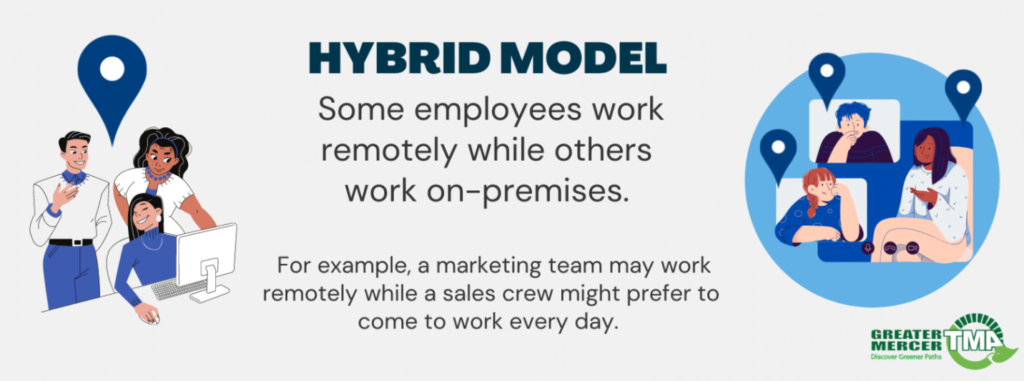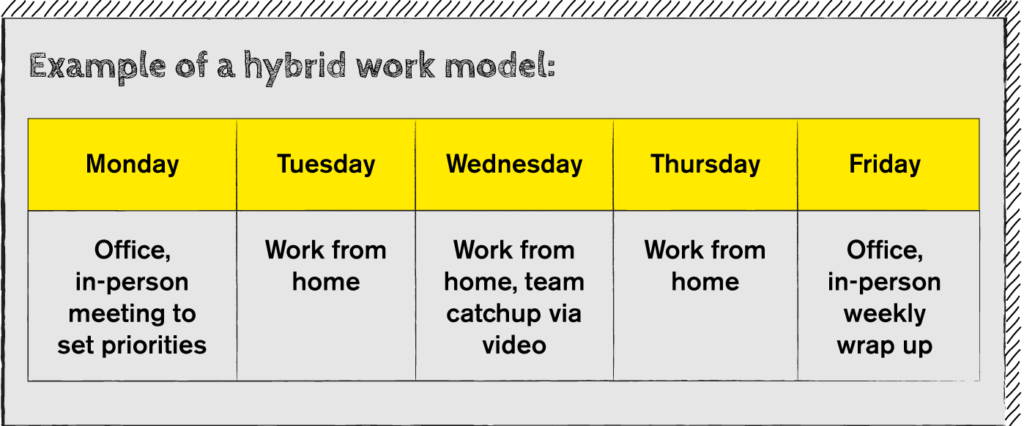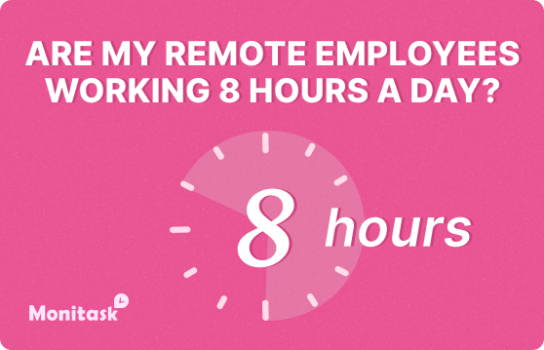Hybrid Work Model: The Future of Workplace

With the current trends of work, a hybrid work model seems like the outlook of the workplace. Why? Because it allows employees to have the best of both worlds: It provides the opportunity for employees to have a flexible work schedule, while still having access to in-person collaboration with their peers and the structure and stability of office space. But transitioning to a hybrid work mode can be challenging for businesses to face.
While it is important to provide the right tools and resources, there are other intangible elements that employers must consider in order to ensure a successful transition to hybrid work. In this blog post, we will explore the secrets of a successful hybrid work model, and how you can transition your business to this new way of working successfully. Stay tuned!

Hybrid Work Model
This type of work model shouldn’t be confused with remote working, where employees are completely remote and don’t physically meet their colleagues. In a hybrid work model, a company decides which teams work from home and which teams work from the office, as well as if this will be a permanent arrangement or if it will rotate.
The hybrid work model was created to provide an alternative to traditional office-based arrangements, while still allowing teams to meet in person and collaborate effectively. This type of hybrid workplace is becoming more popular in the modern era, as more and more companies are realizing that hybrid work models can offer a unique balance for employees.

“Hybrid working is not new, it is new for you.” Dr. Tony de Bree – The Online Gig Economy
However, a hybrid working model is not something new as early in the 1990s the global ABN Amro Bank already had virtual teams. The hybrid model is projected to become the new normal in the workplace “owing to its ability to provide both control and flexibility, as well as reduce commuting stress and environmental impact.”
Benefits of Transitioning to a Hybrid Workplace
Trying out a hybrid work model can offer some unique benefits for your business. Here are just a few of the benefits that hybrid workplaces can bring to businesses, teams, and employees:
- Boosted productivity: Hybrid workplaces can help to increase employee productivity by allowing them to work from their preferred space and at the time that best fits their needs
- Improved team collaboration: Sometimes, meetings can drag on hindering overall performance. Therefore, hybrid workplaces can foster better communication and collaboration among teams, as in-person meetings can be supplemented with virtual collaboration tools
- Increased employee satisfaction: Hybrid workplaces can help to reduce stress and improve job satisfaction by allowing employees to work in an environment that best fits their needs
- Reduced environmental impact: For some companies, the environmental footprint is important. Hybrid workplaces can help to reduce the ecological footprint of businesses by reducing commuting times that cause air and water pollution.
Types of Hybrid Work Models
Some companies adapt their own hybrid work schedules, yet we will be talking about 3 main hybrid work models that businesses can use. These hybrid work models include:
Full Hybrid Work (Required)
This hybrid model is the most common form of hybrid working, as it allows employers to choose which department or team will be working fully remotely or doing office-based work. This schedule can be permanent or it can be used on a rotational basis.
- When to use it? This model is used when companies want to capitalize on the advantages of hybrid working but still maintain some control.
Full Hybrid Work (Voluntary)
In this hybrid model, the hybrid workplace relies on voluntary hybrid work from employees. Employees can choose to work fully remotely or they can come to the office, and there is no compulsion for employees to do either.
- When to use it? This hybrid work model is used when companies want to give their employees more freedom and autonomy.
Split Hybrid Work
This hybrid model involves employees working partially in the office and partially remotely. For example, an employee can choose to work 3 days in the office and 2 from home.
- When to use it? This hybrid model is used when companies want to optimize the hybrid workplace balance and give employees more control over their work schedules.
A schedule of this type of hybrid work model would look this:

The model that works for you will depend on your goals, objectives, and the type of work that you do. Make sure to consider any hybrid workplace regulations in your area when deciding on a hybrid work model.
Hybrid work models can offer a unique balance for employees and provide businesses with many benefits. If you think hybrid working is the right fit for your business, then take the time to consider the hybrid workplace models available and develop a hybrid work model that works best for you.
Yet, when you get to choose the model that works for you. How do I put everything into action?
How to Implement a Hybrid Work Model Successfully
When transitioning to hybrid working, there are a few steps you should take to ensure the transition is successful. Let’s review them!
- Budgeting for Hybrid Work
One of the key elements to success in hybrid working is budgeting. It is important to remember that hybrid workplaces require a hybrid work budget that takes into account the costs associated with remote working, such as additional technology requirements and training materials.
Businesses must also factor in the cost of hybrid working tools, such as video conferencing software and hybrid work collaboration platforms, hybrid training, well-ness packages, and all the benefits and perks associated with this kind of workplace
- Create a Hybrid Workplace Policy
Creating a hybrid workplace policy is an important first step for successful hybrid work implementation. This policy should clearly state employee expectations, including who is eligible, hybrid workplace setup details, and working hours. Furthermore, the policy should specify rules and regulations that employees must abide by while working remotely and hybrid.

Additionally, a hybrid workplace policy should also address remote access policies, communication guidelines and rate of response, protocols that outline any video conferencing platforms as well other security protocol stipulations.
Ultimately, ensuring this hybrid work transition is successful starts with creating clear expectations for hybrid work set out in a hybrid work environment policy.
- Establish a Hybrid Workflow
Establishing a hybrid workflow involves deciding which tasks can be done at home and which ones require a physical presence in the office, while also planning any needed technology investments that would make hybrid working smoother and more efficient.
- Investing in the right tools, such as efficient platforms for virtual collaboration or effective systems for time tracking and attendance management, can ensure an effective hybrid work environment despite employees working remotely.
By carefully evaluating where hybrid working fits best within the business framework, organizations can take appropriate action to implement hybrid strategies and achieve long-term success in this increasingly digital world.
- Set up a Hybrid Workspace
Your hybrid workspace should be equipped with whatever tools are necessary for hybrid work from collaboration technology to virtual meeting platforms. The hybrid workplace should include everything needed to facilitate hybrid working, such as video conferencing and collaborative technologies.
This hybrid workplace can also be designed to accommodate individuals who are working remotely:
- It could consist of both an office setting with comfortable furniture and technology tools or a traditional workspace that is outfitted with the necessary tools, helping to ensure a smooth hybrid work experience for all stakeholders.
The workspace should also feel comfortable yet professional, creating an inspiring environment for creativity and collaboration. Investing in the right technology and creating the ideal hybrid workspace will help ensure successful hybrid working that benefits both employers and employees.
- Communicate Expectations
For hybrid workplaces to be successful, employees must understand the hybrid working policy, workflow, and their roles within it. This includes making sure each employee knows what is expected of them so that they can efficiently navigate between the hybrid workplace demands and deliver results.
Employers should consider how they can best communicate their hybrid policies and workflow across multiple collaboration platforms in an effective manner. Ensuring proper communication will help ensure employees understand the guidelines associated with hybrid work and can better adjust to this new mode of remote operation.
- Establish a Centralized, Cloud-Based System
Establishing a centralized, cloud-based system is an important step for transitioning to hybrid work. With this system, organizations can securely store and access data from anywhere on any device, enabling collaboration and communication from remote locations.
Not only does this drive efficiency in data organization and backup, but it also eliminates the need for physical paperwork, reducing costs. This hybrid workplace enables employees to work seamlessly from any location, ultimately loosening geographical restrictions and increasing employee productivity.
- Create Equal Employee Benefits
With hybrid workplaces, many companies have found themselves facing a new challenge: making sure their workers feel appreciated and valued regardless of where they’re working from.
Companies should prioritize offering separate but equal job benefits for all employees depending on their particular working style to ensure everyone feels valued and appreciated in their role.
Companies need to make sure that their benefits packages are holistic, acknowledging hybrid work staff as well as those who are always in the office
By providing all employees with equal opportunities, a business can ensure each employee feels appreciated and cared for, regardless of where or how they work.
- Optimize Collaboration Both Remote and On-Site
In a hybrid workplace, the ability to foster collaboration between employees who are both remote and on-site is essential for success. Companies need to focus on implementing strategies that will best facilitate communication within hybrid teams, while at the same time fostering strong relationships across geographic and virtual boundaries.
With hybrid work becoming more commonplace, it is important to invest in secure tools that support communication, document sharing, and team collaboration; tools like video conferencing software and project boards help bridge any gaps between coworkers working remotely.
- According to Gartner, hybrid teams that leverage the right collaboration technology are much more successful than those that don’t. Specifically, these teams were 70%more agile, and 66% felt more comfortable in their roles.

Additionally, scheduling regular check-ins with hybrid teams provides an opportunity for everyone to be heard and increases trust among colleagues. Investing in hybrid workplaces will help ensure successful collaborations throughout an organization.
- Monitor Your Progress
As hybrid work becomes more commonplace, it’s essential to monitor progress when implementing hybrid workplace solutions. Management teams should stay up to date with the latest data and analytics available to ensure a successful hybrid workplace transition.
Continuous monitoring of key performance indicators can help identify potential issues quickly and allow teams to adjust their hybrid plans accordingly. Through regular measurement and evaluation, companies can pave the path for a successful hybrid working environment well into the future.
Effective hybrid work requires a thoughtful combination of both physical and virtual working environments. From communication to collaboration and beyond, hybrid workplaces present numerous specific strains on modern organizations.
Common hybrid workplace challenges include:
- Communication silos,
- Lack of visibility between remote and in-office team members,
- Decrease in collaboration,
- Struggles in adapting hybrid work policies for the entire organization,
- Integrating digital tools effectively,
- Maintaining company culture across hybrid workplaces
To help hybrid workplace teams overcome these obstacles it is important to establish communication protocols between both onsite and remote staff while investing in tools that enable employees to collaborate seamlessly.
Companies should also strive to update their policies regularly while encouraging creativity through activities like virtual team-building events or virtual social gatherings.

Finally, providing personalized support and resources can go a long way towards fostering a connection between hybrid workplace teams as they seek to maintain a cohesive workforce despite being dispersed geographically.
Takeaway
Taking the time to plan and implement hybrid work strategies is key to achieving long-term success in today’s increasingly digital world. Companies should prioritize setting up a hybrid workspace, communicating expectations, establishing a centralized system, creating equal employee benefits, and monitoring progress.
By doing so, businesses can ensure hybrid working runs smoothly for both employers and employees. With hybrid working, organizations can unlock new avenues of growth and take their productivity to the next level.
At Monitask, we love to help you improve your workflow. Stay tuned for more blog posts like this one!
-The Monitask Team


